This post may contain affiliate links. Please read our disclosure policy.
Transform ordinary cucumbers into probiotic powerhouses with this time-tested fermented pickles recipe. Whether you’re harvesting from your backyard garden or supporting local farmers at the market, this preservation method lets you enjoy the bounty of summer all year long.
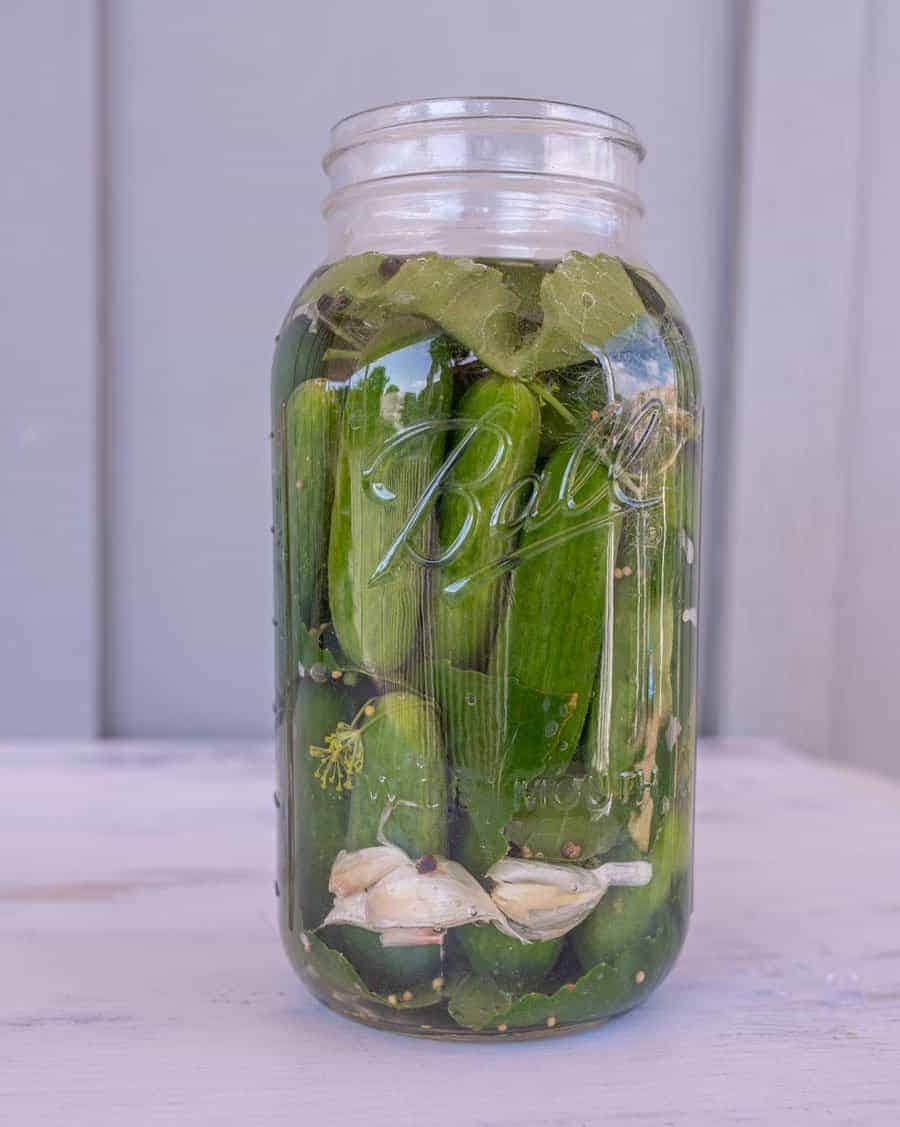
Based on an old-tradition, this recipe makes lacto-fermented dill and garlic pickles that last ages and are full of flavor.
The magic of fermentation lies in its simplicity – just salt, water, and time. These aren’t your typical vinegar-based pickles; instead, they’re alive with beneficial bacteria that transform ordinary cucumbers into crunchy, tangy delights.
Perfect for beginners, this recipe harnesses ancient preservation techniques that have kept families fed through winters for generations. Not only will you master an age-old craft, but you’ll also create pickles that are packed with gut-healthy probiotics, rich in flavor, and free from artificial preservatives.
Note: This recipe is not for canning or bottling cucumbers.
Table of Contents
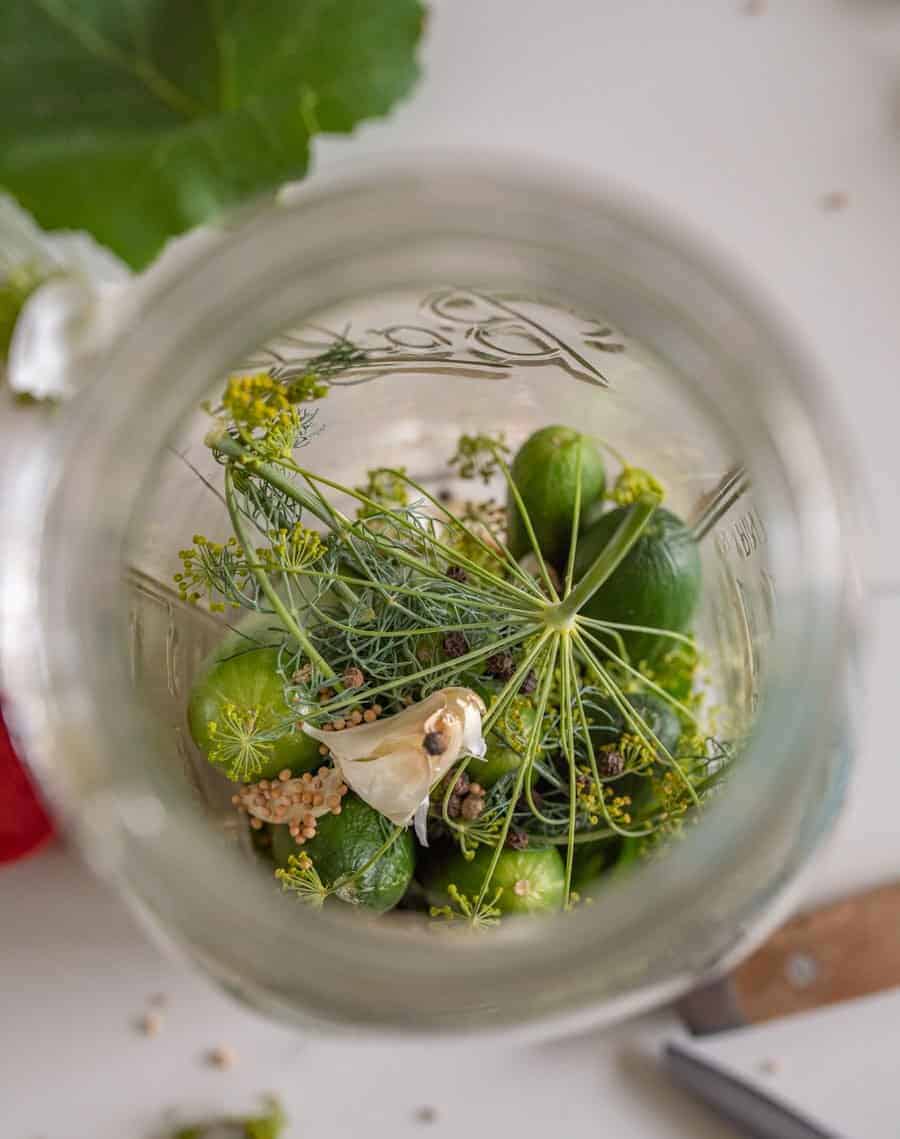
Why You’ll Love This Fermented Pickles Recipe
- No Special Equipment: Uses basic kitchen tools you likely already have. If you really get into fermenting, you can always upgrade later!
- Better Than Store-Bought: Crisp, fresh, and free from artificial preservatives, these pickles are my family’s favorite way to enjoy cucumbers from the summer garden all year long.
- Beginner-Friendly: Making fermented pickles is easy — just a few simple steps with reliable results, perfect for first-time fermenters.
- Set-It-and-Forget-It: Just 15 minutes of active prep time, then let nature do the work.
🥒 Once you make these fermented pickles, you must try making refrigerator pickled banana peppers and learn how to make kombucha — some of my fave fermented recipes!
Recipe Ingredients and Supplies
- Clean glass jar: This recipe calls for a half-gallon canning jar. You can also make fermented pickles in 2 wide-mouth quart canning jars.
- Sea salt: It’s important that the salt you use does not have additives because your goal is to make an environment for good bacteria to live.
- Unchlorinated water: Feel free to buy distilled water. You are trying to make an environment for good bacteria to thrive; chlorinated and heavily treated tap water make it hard for the things you want to live.
- Cucumbers: You can use garden cucumbers, mini English cucumbers (like the kind they sell in a bag all together), or Kirby cucumbers. Look for cucumbers that are similar in size, about 4 inches long, and about as fat as a quarter.
- Seasoning and spices: Fresh dill and garlic are wonderful to add, but you can play around with the seasonings.
- Tannin-containing leaves: Bay leaves (fresh is best), grape leaves, and oak leaves all work. Adding a few of these to your pickling process helps to make the end pickles crisp.
See the recipe card below for full information on ingredients and quantities.
How to Make Fermented Pickles
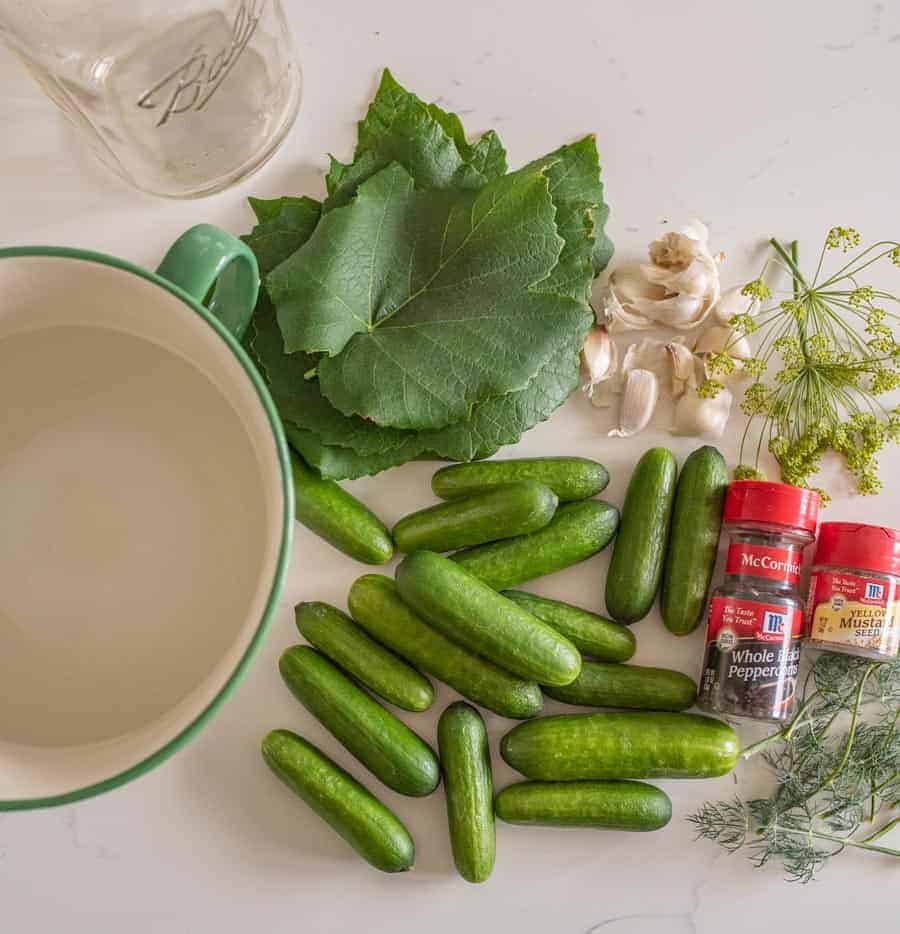
Step 1: Make a brine by dissolving sea salt in water then adding two leaves to the bottom of a clean glass jar.

Step 2: Add half of the spices and cucumbers to the jar and add two more leaves. Then, add the other half of the spices and cucumbers.

Step 3: Fill the jar with brine, cover with a leaf and a weight or rock, and place in a cool, dark place.
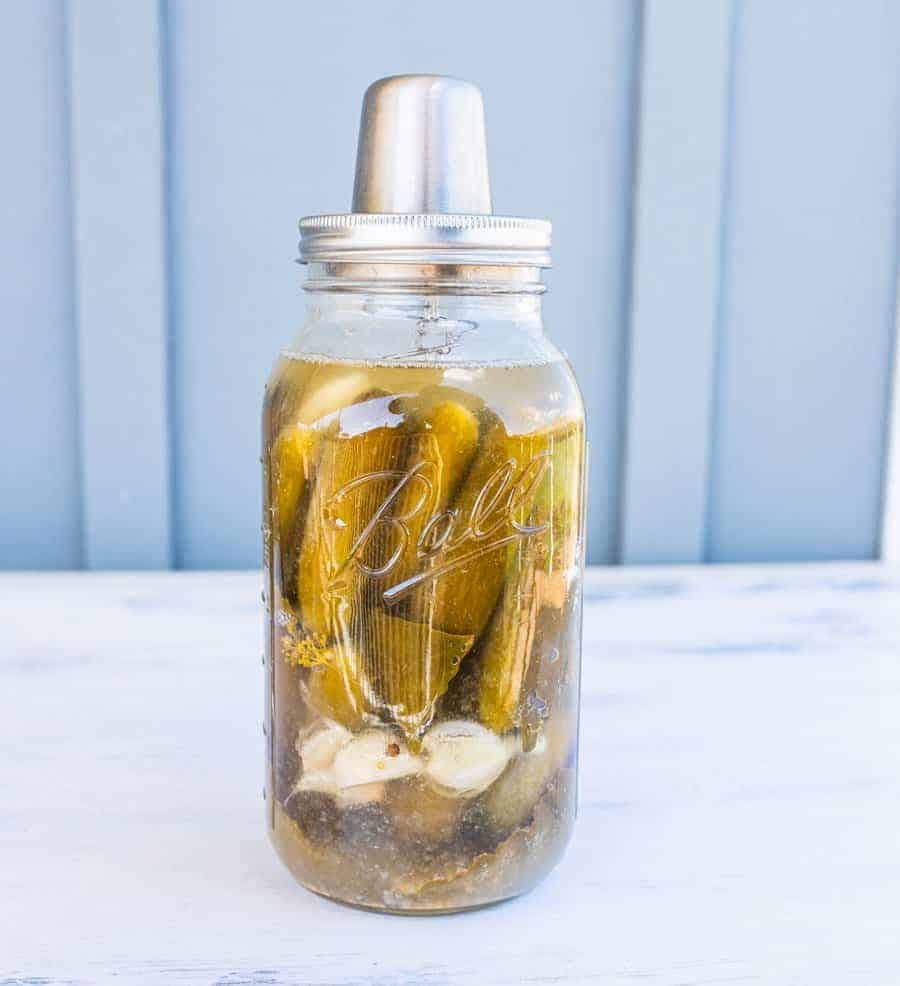
Step 4: Taste after 5-10 days until they reach your desired sourness and then store them in the fridge for up to a year.
Recipe FAQs
You could but whole cucumbers have the best texture for the end pickles, so pick some cucumbers that are a good eating size for you.
Vegetables are placed in a brine and kept submerged there for a few weeks. This allows time for the natural bacteria, especially Lactobacillus, to turn the cucumbers into pickles. You can read more and an in-depth explanation of fermenting here.
Taste! When they taste like a pickle, they are done. Normal fermentation times are 7-21 days. Let them sit for 10-14 days and then check them daily by tasting until the desired sourness is achieved.
You can’t over ferment something. Fermenting for less time makes them less cellar stable, and they may have a few less active cultures. If you ferment your pickles less than a few weeks, keep them in the fridge for longer storage.

Expert Tips
- Bad Mold: If the contents of your jar are fully submerged in the brine you shouldn’t have any issues with mold. If some of the contents are poking out, those will mold. If you find furry mold on something that isn’t fully submerged, you’ll need to toss the whole batch.
- Kahm Yeast: Be aware that you can grow kahm yeast. It looks like a cloudy film on the surface of your brine and is a normal thing. Use a clean spoon to remove the film each day. It won’t be fuzzy.
- Start With Weights: Be aware that even if your cucumbers sink to the bottom of the jar in the beginning they might float a bit at the end, so use a weight (rock) or a lid even if it doesn’t look like you need it on the first day.
- Cloudy Brine: Cloudy brine is normal and will typically happen within the first 3 days or so of the fermenting process. No issue there, in fact, plan on it happening, that’s how you know your pickles are live and active.
- Cucumber Types: Don’t worry too much about what type of cucumber you are using, though I do like to use organic or homegrown when possible (again, the less the contents are treated, the happier your beneficial bacteria will be).
- Tannin Leaves: Don’t skip the leaves with tannins. It’s an extra ingredient compared to many recipes you might find, but it’s my little trick to making amazing pickles at home.
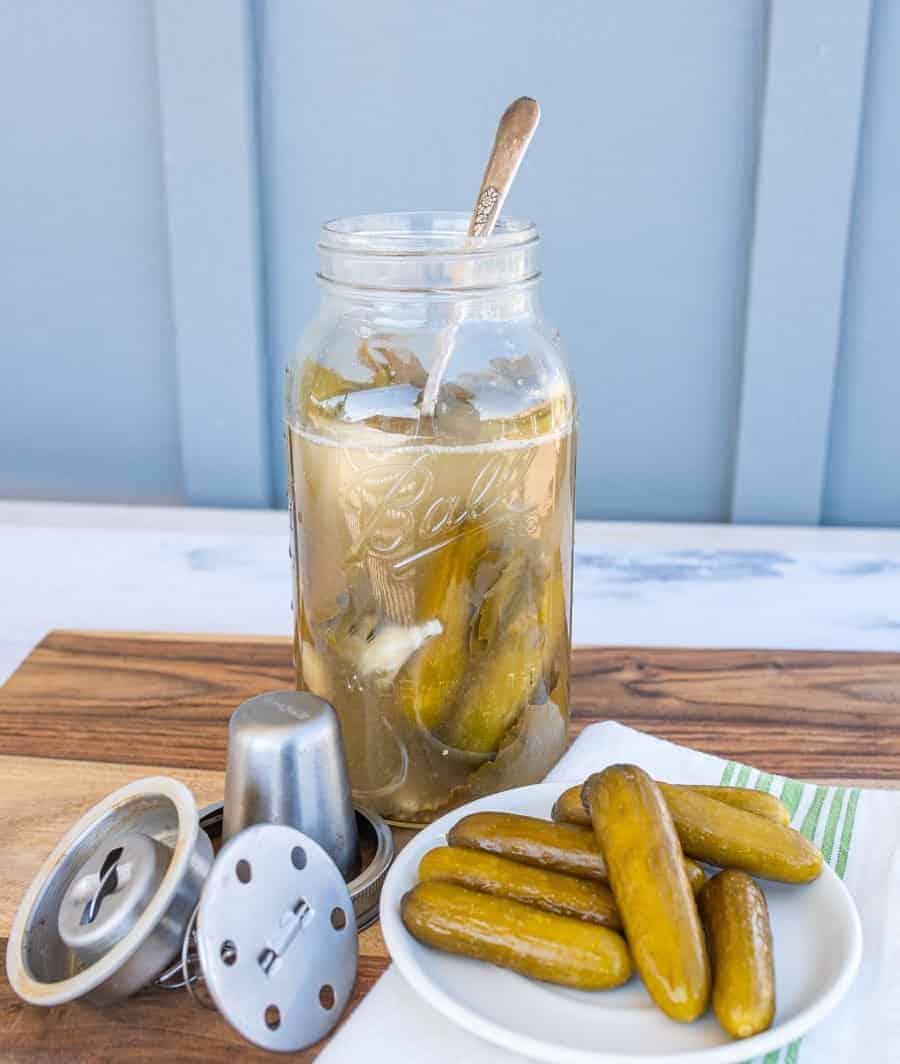
Caps & Lids For Fermenting Food
You can get as complicated as you like for this. The goal for the lid or fermenting tool is to help hold everything in the jar under the brine. Air isn’t good for this process because it will lead to mold, so everything needs to stay fully under the brine.
There are many, many products that are lids or tools for fermenting including:
- Kraut Source lids are easy to use and easy to clean and it works great. It fits on any wide mouth glass canning jar.
- You can also use a rock that is clean and fits inside the top of your jar. The purpose of the rock is to hold everything in the jar down into the brine and the cover will keep out bugs and dust. The rock has to be submerged below the brine too or it will mold.
- If you are using a rock you’ll also want a piece of fabric and a way to secure the fabric (a rubber band or a screw on canning lid without the flat, both work great). Because the cloth cover is light, the gas it creates will be able to easily escape. That being said, the cloth can also let too much brine evaporate, so you have to keep an eye on it.
- These glass weights work like a rock, but aren’t a rock!
Ultimately, use what you have on hand. If this is your first time, go find a rock. There are many different things you can try or invest in and I think they generally work the same, so do what fits your budget.
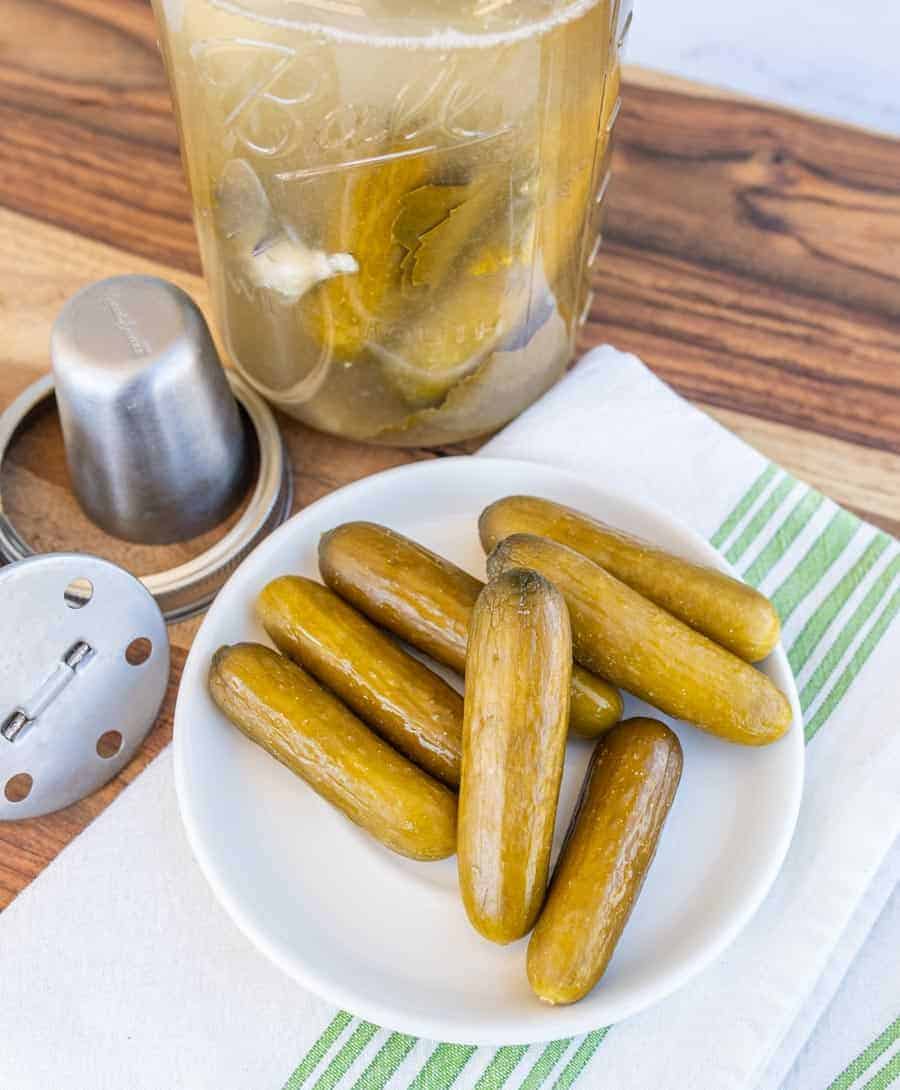
How to Store Fermented Pickles
Once the pickles are to your liking, you can remove the rock or lid and place a traditional lid on the jar. (I like these one piece screw on lids a lot, or just use a canning flat and screw on lid.)
Pickles can be stored in cold storage or a root cellar or kept in the fridge.
If you are storing your pickles out of the fridge just be sure to “burp” the jars (unscrew the lids to release built up gas) every few weeks or so.
More Preserving Recipes to Consider
Preserving Guide
How To Preserve Watermelon
Preserving Guide
How To Preserve Tomatoes
Preserving Guide
How To Preserve Sweet Potatoes
Preserving Guide
How To Preserve Winter Squash
Did you make this recipe? Leave a ⭐️ review and share it on Instagram, Facebook, or Pinterest!
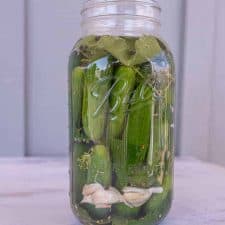
Easy Fermented Pickles Recipe
Ingredients
- 4 tablespoons sea salt
- 6 cups chlorine-free water*
- 5 or 6 grape, oak, horseradish, or bay leaves, (see notes)
- 8 cloves of garlic
- 2 large heads of fresh or dried dill, or 1 heaping tablespoon dill seeds
- 1 teaspoon black peppercorns
- 1 teaspoon mustard seeds
- ½ teaspoon red pepper flakes, optional
- Enough small cucumbers to fill a half-gallon jar, (about a pound)
- Round stone to use as a weight that fits in the jar or a fermenting lid kit
- 1/2 gallon glass canning jar or 2 wide mouth quart glass canning jars, (instructions below are for using a 1/2 gallon jar, if you use 2 quart jars then split the ingredients equally between the two jars)
Instructions
- Make a brine by adding the sea salt to the water and stirring to combine. Stir until the salt dissolves into the water.
- Add 2 of the leaves to the bottom of the clean glass jar.
- Add half of the garlic, half of the dill, half of the peppercorns, half of the mustard seeds, and half the red pepper flakes (if using), to the bottom of the jar.
- Add half of the cucumbers to the jar. I like to pack them in nicely but not so tightly that they are going to bruise each other.
- Add 2 leaves on top of the cucumbers.
- Add the second half of the garlic, dill, peppercorns, mustard seeds, and red pepper flakes (if using) to the 1/2 gallon jar.
- Add the remaining half of the cucumbers to the 1/2 gallon jar.
- Fill the jar with brine so that it covers the cucumbers and comes about an inch from the top of the jar.
- Add the last leaf to the top of the jar and press it down and around the cucumbers so that it helps to cover them in the brine.
- Wash your stone well and place it on top of the leaf. The purpose is to help weigh down the cucumbers and leaf so that all of the cucumbers, leaf, and rock are kept under the brine. You can also use a brining cap for your jar. I have a Kraut Source lid and love it. If you use a rock make sure that it is fully submersed or it will grow mold.
- If you are using a stone, cover the top of the jar with a cloth and screw or tie something around the cloth (like a canning ring or a rubber band) to keep the cloth in place. This will help to prevent flies and dust from getting in your pickles.
- Place the prepared cucumbers in an out-of-the-way place, out of direct light.
- After a few days the brine will get a little cloudy and you’ll see a few bubbles starting to form on or around things in the jar. This is a great sign that the cucumbers are turning into pickles.
- Taste your pickles after 5-10 days. If you’d like them more sour continue letting them sit for up to 4 weeks, tasting as you go along, until desired sourness is achieved. Once the pickles taste to your liking place them covered in your fridge or in cold storage for long term storage. They can stay in your fridge for up to a year.
Notes
- The brine is full of healthy bacteria as well as the pickles. I like to use it in salad dressings, marinate pork and chicken in it, or splash a little in potato or tuna salad.
- The leaves that are listed contain tannins which help to keep the pickles crisp! The top leaf is also being used as a fermentation “cap” meaning it keeps what you are eating under the brine. If you are going to make pickles when grape leaves are not in season, you can pick the grape leaves and let them dry to have on hand for winter fermenting.
- Be sure to use leaves that have not been treated or sprayed with anything. You can skip the leaves all together if you don’t have them, though I do like the crisp pickles better.
- The salt brine is great at keeping things from molding. That being said, if you see mold on or in your pickles you’ll need to throw them out.

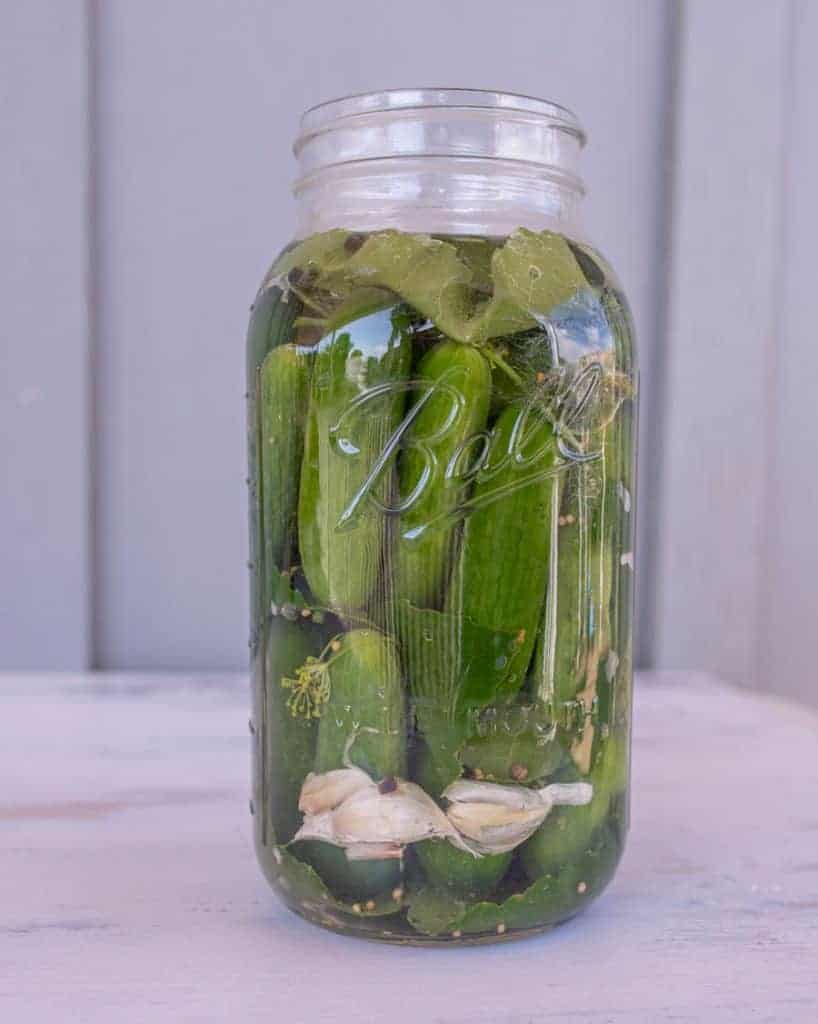
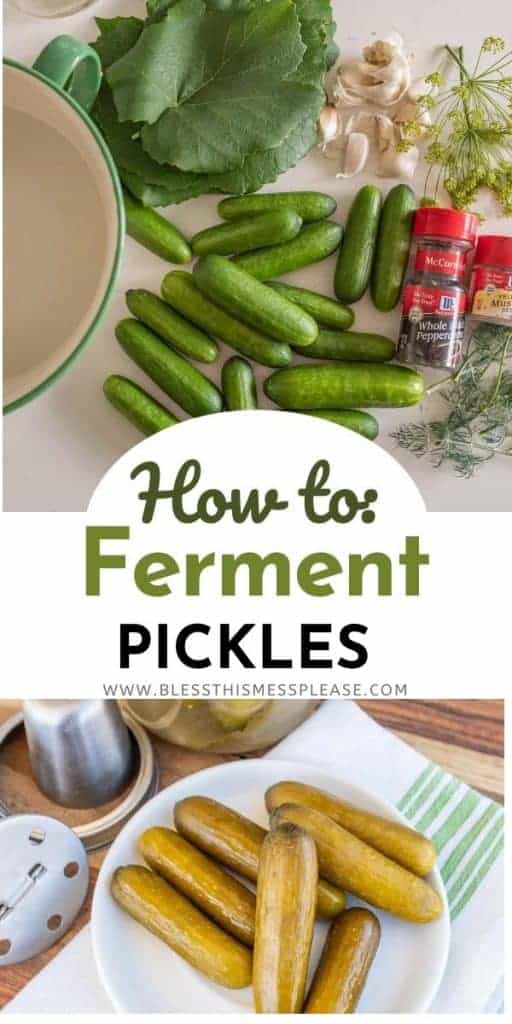
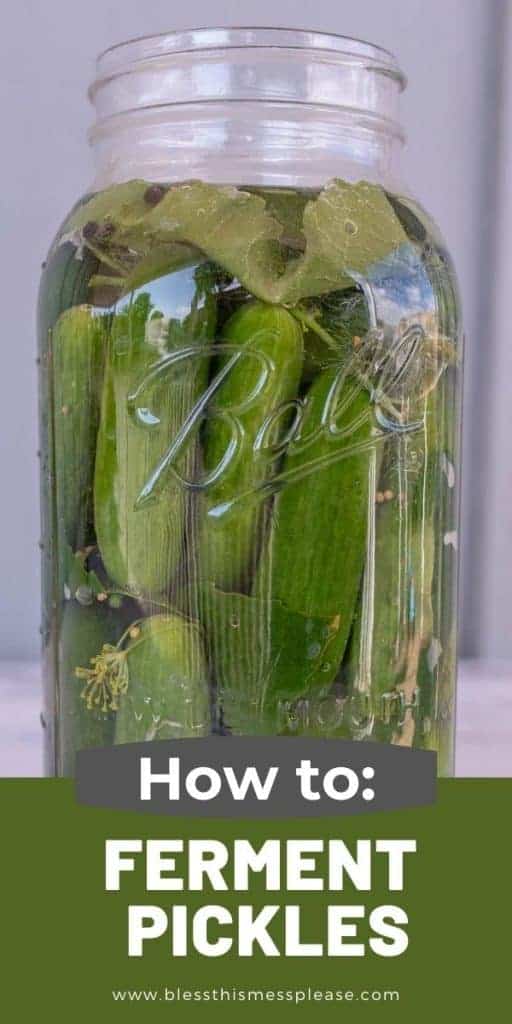
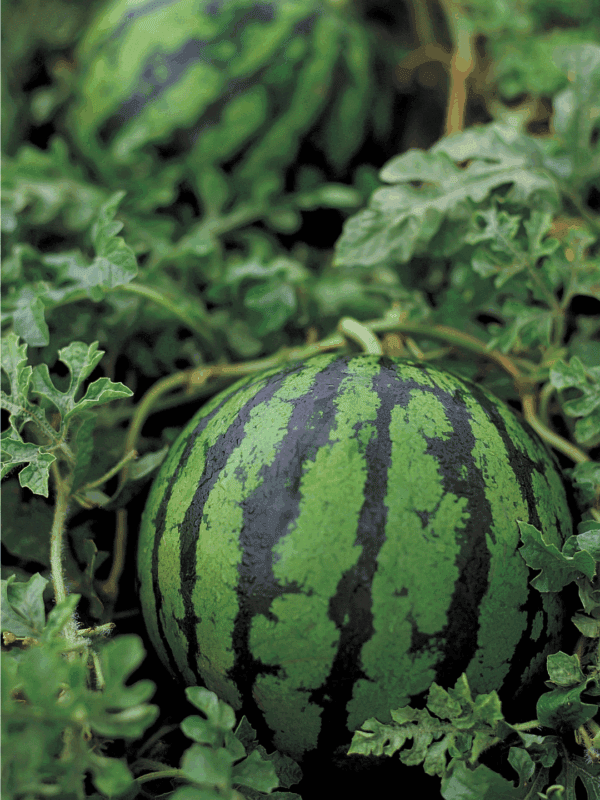
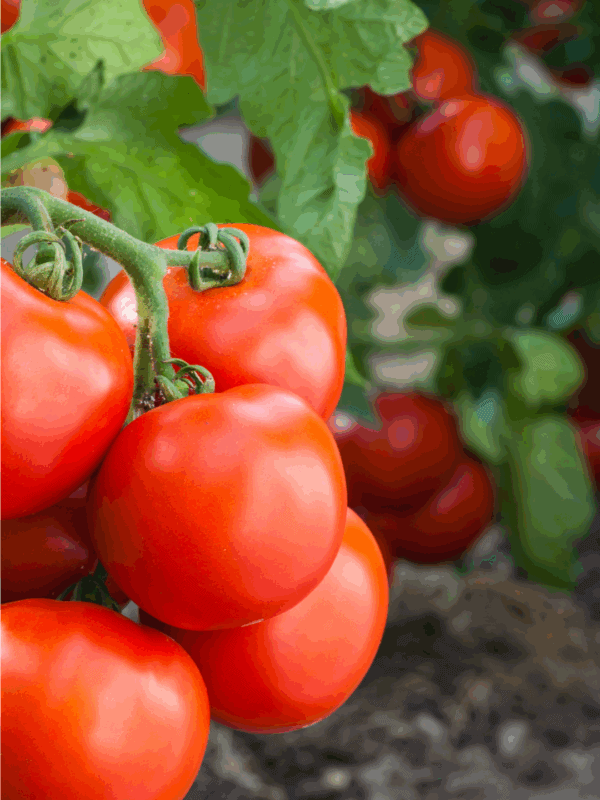
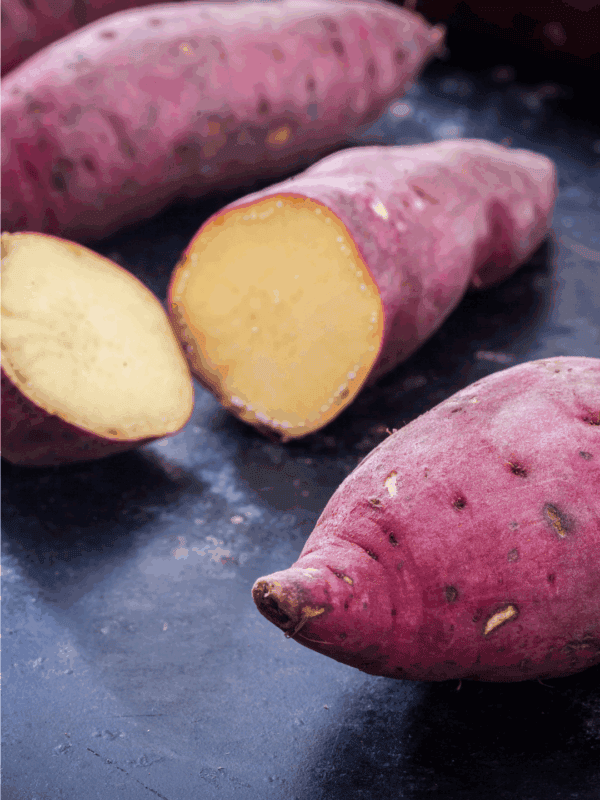
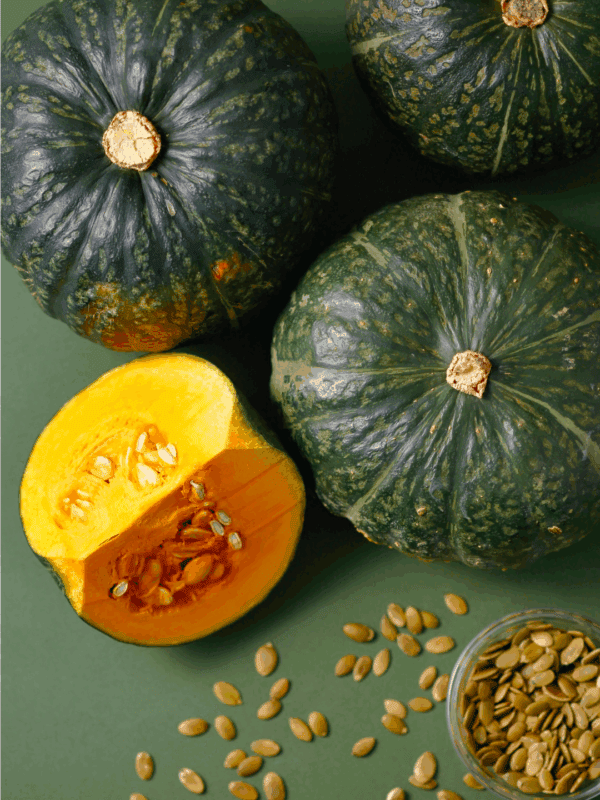






Can the pickles be transferred to smaller jars for refrigeration after fermenting?
Yep, they store great for a long time in the fridge!
Hello. I’ve made your pickle recipe a number of times and I’m generally very happy with the result as they remind me so much of my dad’s pickles when I was a little girl. Now I’m 75 and trying to duplicate his recipe and something just isn’t quite right. I’m thinking it might be the salt but I’m not sure. My question is when you call for 5 TBS of sea salt, are you calling for fine sea salt or coarse sea salt? I look forward to hearing from you hopefully soon as I have my cukes and ask ready to get busy. Thank you!
I use coarse! I’ll note that in the recipe. Hmmm did you dad ever put in a clove or garlic, fresh chives, or dill? It could totally just be the salt ratio though. I hope you get it sorted out and that you get transported right back to childhood when you do. Thanks for the comment Sandra!